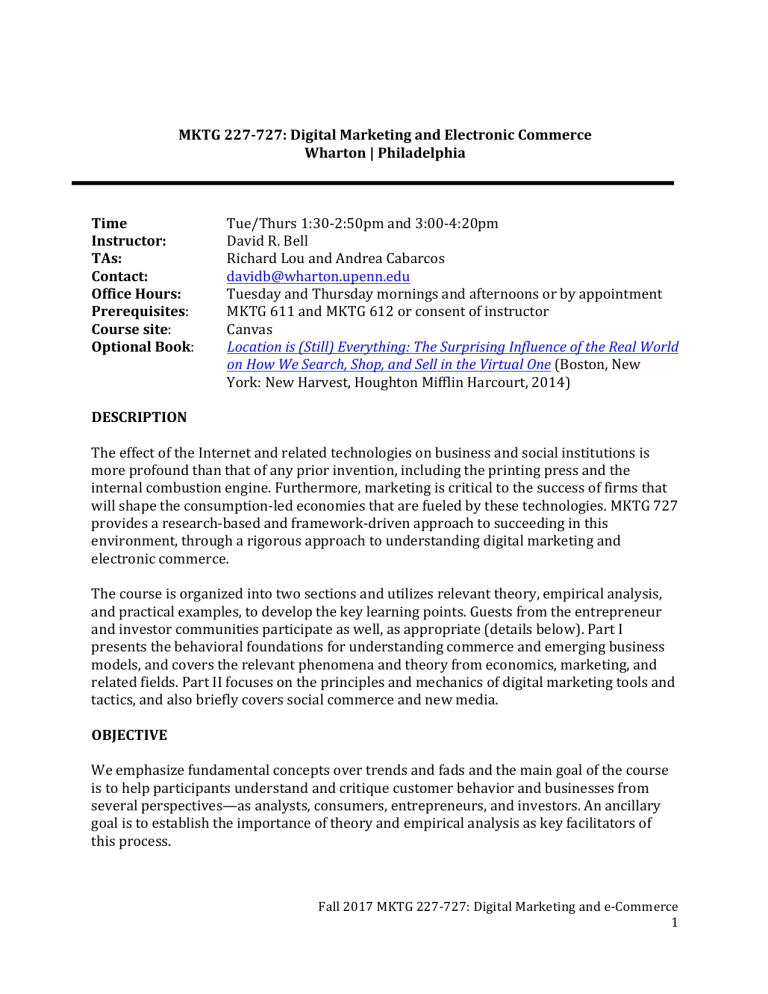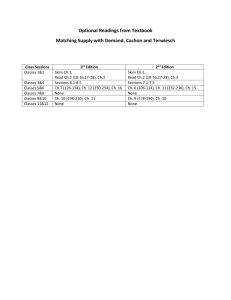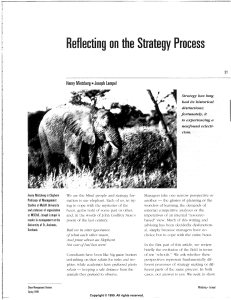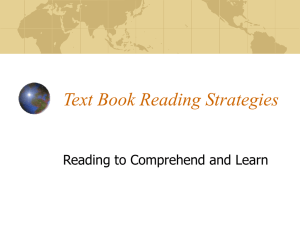
MKTG 227-727: Digital Marketing and Electronic Commerce Wharton | Philadelphia Time Instructor: TAs: Contact: Office Hours: Prerequisites: Course site: Optional Book: Tue/Thurs 1:30-2:50pm and 3:00-4:20pm David R. Bell Richard Lou and Andrea Cabarcos davidb@wharton.upenn.edu Tuesday and Thursday mornings and afternoons or by appointment MKTG 611 and MKTG 612 or consent of instructor Canvas Location is (Still) Everything: The Surprising Influence of the Real World on How We Search, Shop, and Sell in the Virtual One (Boston, New York: New Harvest, Houghton Mifflin Harcourt, 2014) DESCRIPTION The effect of the Internet and related technologies on business and social institutions is more profound than that of any prior invention, including the printing press and the internal combustion engine. Furthermore, marketing is critical to the success of firms that will shape the consumption-led economies that are fueled by these technologies. MKTG 727 provides a research-based and framework-driven approach to succeeding in this environment, through a rigorous approach to understanding digital marketing and electronic commerce. The course is organized into two sections and utilizes relevant theory, empirical analysis, and practical examples, to develop the key learning points. Guests from the entrepreneur and investor communities participate as well, as appropriate (details below). Part I presents the behavioral foundations for understanding commerce and emerging business models, and covers the relevant phenomena and theory from economics, marketing, and related fields. Part II focuses on the principles and mechanics of digital marketing tools and tactics, and also briefly covers social commerce and new media. OBJECTIVE We emphasize fundamental concepts over trends and fads and the main goal of the course is to help participants understand and critique customer behavior and businesses from several perspectives—as analysts, consumers, entrepreneurs, and investors. An ancillary goal is to establish the importance of theory and empirical analysis as key facilitators of this process. Fall 2017 MKTG 227-727: Digital Marketing and e-Commerce 1 VALUE PROPOSITION Course participants will have a solid foundation from which to: (1) evaluate opportunities in the digital and e-commerce ecosystem, and (2) develop their own ventures. ASSESSMENT • • • Attendance and Participation: Group Assignment, details TBA Final Exam: 20% 30% 50% SCHEDULE Session 1 Month Oct Date Thu 19 2 3 4 5 6 Oct Tue 24 Thu 26 Tue 31 Thu 02 Tue 07 Nov 7 8 Thu 09 Tue 14 9 Thu 16 10 Tue 21 11 Nov 12 13 14 Tue 28 Thu 30 Dec Tue 05 Thu 07 Topic Introduction to “Digital Marketing, Social Media, and eCommerce” Marketing Assets in the Digital Economy Guest: Lawrence Lenihan Co-CEO of Resonance Internet GRAVITY and Frictionless Commerce Classic Case: “Webvan” (Internet Economics) Contemporary Case: “Warby Parker” (Digitally Native Vertical Brands / Margin Disruption) Guest: Stephen Kuhl Founder and CEO of Burrow Guests: Patrick Duffy and Boyd Renner, Founders Endeavor Life Sciences Offline-Offline Substitution and the Long Tail, Networks and Neighborhoods Work on A1: Watch investors Aileen Lee, Kirsten Green, and Eurie Kim (in that order) located on the Recordings page of the Canvas site Thanksgiving Break Reputation and Reviews plus Online Advertising and Marketing Optimization: Optimal Bidding on Keywords Guests: Pete Borum and Ben Williams Reelio Notes Earned and Social Media, Social Advertising, Mobile Diffusion Over Networks: Viral Features of Products, New Media, and Course Summary A1 Due No inclass session Fall 2017 MKTG 227-727: Digital Marketing and e-Commerce 2 VIRTUAL GUESTS (Available via Spike for the Group Assignment) • Kirsten Green. Kirsten is the Founder of Forerunner Ventures, a premier brandbuilding commerce VC based in San Francisco. Kirsten and her team have a unique investment thesis, “who’s who” portfolio, some high profile recent exits (Dollar Shave Club ($1b); Jet ($3b)). • Eurie Kim. Eurie is a graduate of the Wharton School (WG ’09) and partner at Forerunner Ventures (see above) and spoke to our class in San Francisco on 11/02/2016. • Aileen Lee. Aileen is Founder Partner at Cowboy Ventures, an early stage venture fund, and formerly a partner at Kleiner Perkins Caufield Bowers. A successful investor and operator, Aileen also introduced the “unicorn” idea into the vernacular with her influential article Welcome to the Unicorn Club. VIRTUAL GUESTS (Available via Canvas for viewing only, no assignment) • Rob Coneybeer. Rob is a Wharton graduate and partner at Shasta Ventures where he focuses on mobile and connected hardware. • Philip Winter. Philip graduated from Penn in 2012 and founded Nebia. The first product is a shower that uses 70% less water than conventional showers. Notable investors include Tim Cook and Eric Schmidt. IN CLASS GUESTS • Lawrence Lenihan is the co-founder and co-CEO of Resonance, an early stage fashion-oriented venture studio. Previously, he founded Firstmark Capital. • Stephen Kuhl. Stephen (WG ’17) is the founder and CEO of Burrow an online-first furniture brand based in New York City • Pete Borum and Ben Williams. Pete and Ben (both WG ’13) are founders at Reelio, an influencer marketing business based in New York City. • Patrick Duffy and Boyd Renner. Partick and Boyd, along with their team of with former Navy SEALS are world renowned tattoo artists will discuss the digital go-tomarket strategy for a “new to the world” and about to launch DNA microencapsulation product. The product allows individuals to connect to the people, places, and experiences that bring meaning to their lives. Fall 2017 MKTG 227-727: Digital Marketing and e-Commerce 3 CASES AND ACADEMIC (REFERENCE) READINGS (On Study.Net) Cases 1. “Webvan: Groceries on the Internet” (HBS Case 500052-HCB-ENG, Revised March 25, 2003). 2. “Warby Parker: Vision of a ‘Good’ Fashion Brand” (HBS Case 9-413-051, Revised, September 19, 2012). Academic Readings • • • • • • • • • • • • • • • • • • • Bell, D., J. Choi, and L. Lodish (2012), “What Matters Most in Internet Retailing” Sloan Management Review. Bell, D., S. Gallino, and A. Moreno (2014), “How to Win in an Omni Channel World” Sloan Management Review. Bell, D., S. Gallino, and A. Moreno (2017), “Revenge of the Store” Sloan Management Review, forthcoming. Blum, B. and A. Goldfarb (2006), “Does the Internet Defy the Law of Gravity?” Journal of International Economics. Choi, J. and D. Bell (2011), “Preference Minorities and the Internet,” Journal of Marketing Research. Bell, D. and S. Song (2007), “Neighborhood Effects and Trial on the Internet: Evidence from Online Grocery Retailing,” Quantitative Marketing and Economics. Trusov, M., A Bodapati, and R. Bucklin (2010), “Determining Influential Users in Internet Social Networks,” Journal of Marketing Research. Dellarocas, C. (2010), “Online Reputation Systems: How to Design One That Does What You Need,” Sloan Management Review. D. Mayzlin, Y. Dover, and J. Chevalier (2014), “Promotional Reviews: An Empirical Investigation of Online Review Manipulation,” American Economic Review. Goldfarb, A. and C. Tucker (2011), “Online Display Advertising: Targeting and Obtrusiveness,” Marketing Science. Goldfarb, A. and C. Tucker (2011), “Search Engine Advertising: Channel Substitution When Pricing Ads to Context,” Management Science. Choi, J., D. Bell, and L. Lodish (2012), “Marketing and IS-Enabled Customer Acquisition on the Internet,” Management Science. Rutz, O. and R. Bucklin (2010), “From Generic to Branded: A Model of Spillover in Paid Search Advertising,” Journal of Marketing Research. B. Skiera, N. Nabout (2012), “PROSAD: A Bidding Decision Support Engine for Profit Optimizing Search Engine Advertising,” Marketing Science. McKinsey and Co. (2012), “Turning Buzz into Gold.” Nunes, J. and X. Dreze (2006), “Your Loyalty Program is Betraying You,” Harvard Business Review. Holt, D. (2016), “Branding in the Age of Social Media,” Harvard Business Review. Kumar, V. and R. Michandanl (2012), “Increasing the ROI of Social Media Marketing,” Sloan Management Review. Zalmanson, L. and G. Oestreicher-Singer (2016), “Turning Content Viewers into Subscribers,” Sloan Management Review. Fall 2017 MKTG 227-727: Digital Marketing and e-Commerce 4 DETAILED READING SCHEDULE* Session 1 Introduction (10/19) Session 2 Marketing Assets in the Digital Economy (10/19) Session 3 Lawrence Lenihan (10/26) • Skim / Read according to your interest, articles on Business of Fashion and elsewhere written by Lawrence Lenihan. Session 4 Internet GRAVITY and Frictionless Commerce (10/31) • Skim Blum, B. and A. Goldfarb (2006), “Does the Internet Defy the Law of Gravity?” Journal of International Economics. • Skim Bell, D. and S. Song (2007), “Neighborhood Effects and Trial on the Internet: Evidence from Online Grocery Retailing,” Quantitative Marketing and Economics. Session 5 Webvan (11/02) • Read “Webvan: Groceries on the Internet,” HBS Case 500052-HCB-ENG, Revised March 25, 2003. Session 6 Warby Parker (11/07) • Read “Warby Parker: Vision of a ‘Good’ Fashion Brand,” HBS Case 9-413-051, Revised, September 19, 2012. • Read Bell, D., S. Gallino, and A. Moreno (2014), “How to Win in an Omni Channel World” Sloan Management Review. • Skim Bell, D., S. Gallino, and A. Moreno (2017), “Revenge of the Store,” Sloan Management Review. Session Stephen Kuhl, Burrow (11/09) • Read Bell, D., J. Choi, and L. Lodish (2012), “What Matters Most in Internet Retailing,” Sloan Management Review. • Skim Choi, J. and D. Bell (2011), “Preference Minorities and the Internet,” Journal of Marketing Research. • Skim Trusov, M., A Bodapati, and R. Bucklin (2010), “Determining Influential Users in Internet Social Networks,” Journal of Marketing Research. Session 8 Patrick Duffy and Boyd Renner, Endeavor Life Sciences (11/14) Session 9 Online-Offline Substitution and The Long Tail Networks and Neighborhoods (11/16) • Read Bell, D., J. Choi, and L. Lodish (2012), “What Matters Most in Internet Retailing,” Sloan Management Review. • Skim Choi, J. and D. Bell (2011), “Preference Minorities and the Internet,” Journal of Marketing Research. • Skim Trusov, M., A Bodapati, and R. Bucklin (2010), “Determining Influential Users in Internet Social Networks,” Journal of Marketing Research. Session 10 “Unicorns” Assignment A1 (No In-Class Session) • Read Aileen Lee’s original TechCrunch article “Welcome to the Unicorn Club,” and begin watching Aileen, Eurie, and Kirsten on Spike (all three videos). Fall 2017 MKTG 227-727: Digital Marketing and e-Commerce 5 THANKSGIVING BREAK Session 11 Marketing Optimization: Optimal Bidding on Keywords, plus Reputation and Reviews and Online Advertising (11/28) • Skim B. Skiera, N. Nabout (2012), “PROSAD: A Bidding Decision Support Engine for Profit Optimizing Search Engine Advertising,” Marketing Science. • Read Dellarocas, C. (2010), “Online Reputation Systems: How to Design One That Does What You Need,” Sloan Management Review. • Skim D. Mayzlin, Y. Dover, and J. Chevalier (2014), “Promotional Reviews: An Empirical Investigation of Online Review Manipulation,” American Economic Review. • Review. • Skim Goldfarb, A. and C. Tucker (2011), “Online Display Advertising: Targeting and Obtrusiveness,” Marketing Science. Session 12 Pete Borum and Ben Williams (11/30) • Skim / Read according to your interest, articles on Influencer Marketing and familiarize yourself with Reelio Session 13 Earned and Social Media, Social Advertising, Mobile (12/05) • Read Holt, D. (2016), “Branding in the Age of Social Media,” Harvard Business Review. • Skim McKinsey and Co. (2012), “Turning Buzz into Gold.” • Skim Fang, Z., X. Luo, and M. Keith (2014), “How Effective is Location-Targeted Mobile Advertising,” Sloan Management Review. • Skim Schulze C., L. Scholer, and B. Skiera (2015), “Customizing Social Media Marketing,” Sloan Management Review. Session 14 Diffusion Over Networks: Viral Features of Products (12/07) • No Reading! * YellowDig serves as a “living library” of content to which we all contribute. Please do allocate some time at the beginning of each week to skim through the content posted there. Fall 2017 MKTG 227-727: Digital Marketing and e-Commerce 6






